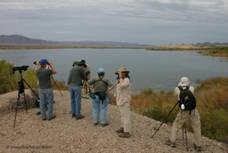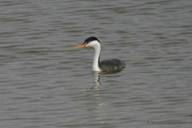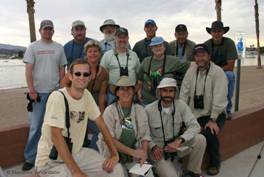 |
 |
|||||||||||||||||||||
|
||||||||||||||||||||||
AZFO FIELD EXPEDITION
Lower Colorado River Survey Summary
11-12 November 2006
Thirteen Arizona Field Ornithologists (AZFO) participated in our Field Expedition to the lower Colorado River in an effort to gain better knowledge of late fall migration in this irregularly birded part of the state. With its large open bodies of water, extensive marshes, scattered wildlife refuges, and north to south flowing-drainage, this section of the river attracts tens of thousands of migrating birds each year.
 On the first morning (11 November), nine team members surveyed different sections of Havasu National Wildlife Refuge from Topock Marsh north. Birds of note along the New South Dike were a Northern Parula and Plumbeous Vireo in the small stand of cottonwoods. We also found a roving band of 15-20 Bushtits foraging through one of the cottonwoods, there, which is a species considered rare along the River. Many flocks of Common Mergansers and a few Red-breasted Mergansers were noted flying south high overhead in the early morning hours. Five-Mile Landing harbored a late Yellow Warbler, 1 Bonaparte’s Gull, 200+ Snow Geese, and a dozen or so American White Pelicans. Also observed here was a pair of Clark's Grebes tending two half-grown downy chicks further suggesting that Clark’s and Western Grebes can be found nesting locally throughout the year along sections of the lower Colorado River. Unfortunately, for our surveying activities, Pintail Slough was open to "duck hunters only" during the morning hours, so we were unable to survey this often-productive location.
On the first morning (11 November), nine team members surveyed different sections of Havasu National Wildlife Refuge from Topock Marsh north. Birds of note along the New South Dike were a Northern Parula and Plumbeous Vireo in the small stand of cottonwoods. We also found a roving band of 15-20 Bushtits foraging through one of the cottonwoods, there, which is a species considered rare along the River. Many flocks of Common Mergansers and a few Red-breasted Mergansers were noted flying south high overhead in the early morning hours. Five-Mile Landing harbored a late Yellow Warbler, 1 Bonaparte’s Gull, 200+ Snow Geese, and a dozen or so American White Pelicans. Also observed here was a pair of Clark's Grebes tending two half-grown downy chicks further suggesting that Clark’s and Western Grebes can be found nesting locally throughout the year along sections of the lower Colorado River. Unfortunately, for our surveying activities, Pintail Slough was open to "duck hunters only" during the morning hours, so we were unable to survey this often-productive location.
 Heading south for the afternoon, four additional AZFO members joined the ranks to assist surveying sections of
Heading south for the afternoon, four additional AZFO members joined the ranks to assist surveying sections of
The Bill Williams River Delta held a good number of gulls (100+) including a few Herring and California Gulls, 1 Forster’s Tern, 15 Red-breasted Mergansers, and 1 female Hooded Merganser. The area below Parker Dam produced 2 additional female-plumaged Surf Scoters, 12 Common Goldeneyes including two adult males, and many Buffleheads, including a flock of 75 downstream of the Dam. Kurt Radamaker and David Powell discovered a Black-and-white Warbler at the Parker Oasis earlier in the morning on their way to join the Expedition.
 The second day of the Field Expedition (12 November) was much quieter than the first day (how could we top a state record-high Common Loon count?), but we still had a few good birds at various points south. Our day began where the previous day ended, around Site 6 on Lake Havasu, in an effort to relocate the large loon concentration and search for other possible species mixed in with the group. Sadly, it appeared that our raft had dispersed and only a single Common Loon saw fit to stay behind. Hundreds of Clark’s Grebes were supplemented by 12 Eared and 5 Horned Grebes. Several flocks of Common Mergansers flew by, as did a flock of Redheads and 2 Osprey.
The second day of the Field Expedition (12 November) was much quieter than the first day (how could we top a state record-high Common Loon count?), but we still had a few good birds at various points south. Our day began where the previous day ended, around Site 6 on Lake Havasu, in an effort to relocate the large loon concentration and search for other possible species mixed in with the group. Sadly, it appeared that our raft had dispersed and only a single Common Loon saw fit to stay behind. Hundreds of Clark’s Grebes were supplemented by 12 Eared and 5 Horned Grebes. Several flocks of Common Mergansers flew by, as did a flock of Redheads and 2 Osprey.
Our next stop was the Bill Williams NWR, at the overlook from the Refuge Headquarters. Mixed in with the many Clark’s Grebes were a few Western Grebes, various duck species and amongst the many Ring-billed Gulls was a probable distant California Gull. The road back to some excellent riparian habitat was closed, so regrettably we didn't have the time to hike back the several miles to survey this intriguing area. (It should be noted that this extensive riparian area is highly deserving of attention during migration, and could be surveyed for wintering vagrants.) Parker Dam yielded the birds mentioned from our first day, but in smaller numbers with only 1 female Surf Scoter, 7 Common Goldeneye, and some Bufflehead.
The Parker Oasis, which the remaining team checked a bit too late in the morning did not relocate the Black-and-white Warbler and encountered nothing else unusual. However, the bird activity remained high, and this area regularly attracts migrants and vagrants in season so is always worth a visit.
In summary, the Field Expedition was successful in discovering some interesting things about the phenomenon of late fall migration in western Arizona. For example, we noticed that the daily rate of turnover of waterfowl and other aquatic birds is very high during this season. The unprecedented concentration of Common Loons discovered late on the afternoon of 11 November was not present the next morning. This seems to suggest the importance of the area as a stopover point, however brief, for loons and other aquatic birds. Well-vegetated points on the river, like Havasu NWR north of Topock, might harbor many birds that are considered rare locally or statewide. Bushtits are considered rare along the river during the fall and winter with the closest known Arizona breeding area >25 miles to the east. The Northern Parula was only found because one of the team members was at least familiar enough with common chip notes to know that this was different.
What else might be discovered if regular observations were taken during migration at all points of the river? Many of the most interesting avian records from the lower Colorado River come from the 1970s and early 1980s when experienced avian biologists conducted surveys throughout the year. In addition, many birds may be seen and recorded by experienced observers, but are not reported to a central body of ornithological information like the Arizona Field Ornithologists, or for rarer birds, the Arizona Bird Committee. With a few more eyes and ears, and a few more reports from under birded (or underreported) areas such as the lower

Many thanks to the AZFO Field Expedition team for their tireless efforts and dedication. Team members included Troy Corman, Steve Ganley, Brian Ison, Doug Jenness, Keith Kamper, Larry Norris, Dave Powell, Kurt Radamaker, Scott Schuette, Tice Supplee, Marceline Vandewater, Danela Yellan, and John Yerger. Once again, Marceline provided the photo documentation of the Field Expedition.
|
©2005
|
HOME | | | REPORT SIGHTINGS | | | PHOTOS | | | BIRDING | | | JOURNAL | | | ABOUT US | | | CHECKLISTS | | | AZ BIRD COMMITTEE | | | EVENTS | | | LINKS |